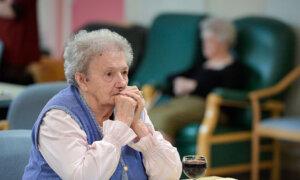How the power of music can transform the lives of people living with dementia?

Dementia is the umbrella term used to describe the gradual loss of brain function due to natural changes in the brain structure, which leads to Alzheimer’s disease.
For individuals living with this progressive condition, the gradual erosion of communicating effectively and maintaining social connections presents itself as impaired memory, thinking, and decision-making abilities, often placing a strain on relationships with family and loved ones.
According to the World Health Organization, the number of people living with it is estimated at more than 50 million, and will triple by 2050. No cure exists, but studies have shown the key to effective management could lie in music.
Especially in aged care, the quest for effective, non-pharmacological interventions to enhance the quality of life and cognitive function of patients is ongoing.
Music therapy has a long history, is evidence-based, and offers a unique blend of emotional, cognitive, and social benefits.
Defined by the American Music Therapy Association, music therapy is the clinical use of music interventions to achieve individualized goals within a therapeutic relationship.

For individuals with Alzheimer’s, these goals often center around cognitive function, memory recall, emotional well-being, and social interaction.
A growing body of research worldwide highlights the success of music therapy in meeting these objectives.
Implementing Harmony: Music Therapy in Practice
The application of music therapy in aged care and Alzheimer’s treatment largely involves personalized music interventions (playing instruments, singing, listening, song writing, and more), tailored to the individual’s history and cognitive abilities. This approach ensures that the therapy is not only effective but also has relevance to the patient.
In facilities and organizations, music therapists work closely with healthcare professionals, caregivers, and families to integrate music therapy into the broader care plan, to offer a coordinated and holistic approach to treatment.
One key study, “Effects of Music Therapy on Patients with Dementia,” published in the National Library of Medicine in 2020, highlights the impact of music therapy with those experiencing early-stage dementia.
The research revealed that music interventions, either with a group or individually, could lead to improvements in cognitive function, mood, and quality of life through active (playing instruments) or passive participation (listening).
The study also notes that music therapy has a long history. The first documented session in the 1800s consisted of musicians performing in patients’ wards. The benefits included a reduction in physical pain and produced a “calming and stimulating” effect.
The Melodic Memory: Music as a Cognitive Enhancer
Other scientific studies have shown that music memories often remain in the brain, even when communication and memories disappear. This is because regions of the brain responsible for musical memory and processing don’t appear to be affected by Alzheimer’s.
The connection between these is extensive and music therapy capitalizes on this connection, making use of familiar melodies and rhythms to stimulate memory recall and cognitive function.
In Alzheimer’s Research & Therapy, March 2023, a study demonstrated that music therapy not only improves the cognitive abilities but also reduces the symptoms of mood like depression in Alzheimer’s patients.
In this evidence-based research, a controlled trial with Alzheimer patients in Europe, China, and the United States was conducted. It compared music therapy with standard care or other non-musical intervention and the evaluation of cognitive functions.
The result? When compared to various control groups, there was a noticeable improvement in cognitive functions following the use of music therapy. This improvement was even more pronounced when patients actively participated in musical activities.
Medicinal Benefits: Emotional and Social Well-Being
Beyond the cognitive improvement, music therapy also offers a multitude of emotional and social benefits.
According to Medical News Today, music therapy has been found to improve the overall well-being of people with Alzheimer’s, their caregivers, and loved ones.
The therapeutic use of music fosters emotional expression, reduces anxiety and agitation, and enhances social interaction among patients. This is particularly valued in aged care settings, where concerns of social isolation and emotional distress is high.
The Future Tune: Advancing Research and Practice
New developments and insights are ongoing, showing how we can reduce the condition of dementia by first addressing factors that affect our brain health. Some of these new developments include blood testing when diagnosing early signs of dementia.
With the current evidence supporting management tools such as the benefits of music therapy, Alzheimer’s care is increasing and this research is key to shedding light on its mechanisms, optimizing intervention strategies, and establishing standardized methods.
Future studies show the continued focus on the long-term effects of music therapy, its impact on disease progression, and its integration with other non-pharmacological interventions.
Music therapy represents a powerful, non-invasive, and cost-effective intervention in the care of individuals with Alzheimer’s, offering significant benefits in cognitive function, emotional well-being, and social interaction.
In Alzheimer’s treatment, it holds one of the foundations to the quality of life for individuals living with this challenging disease.





